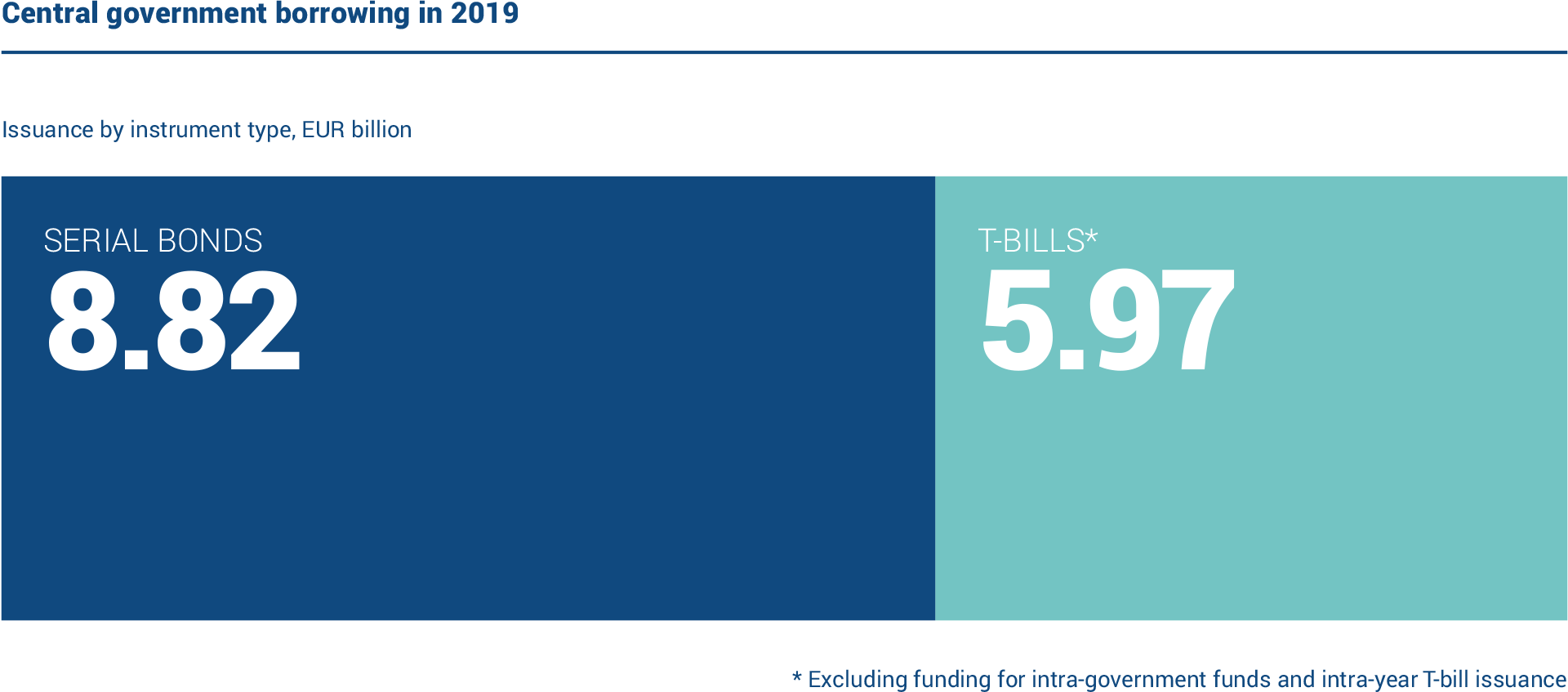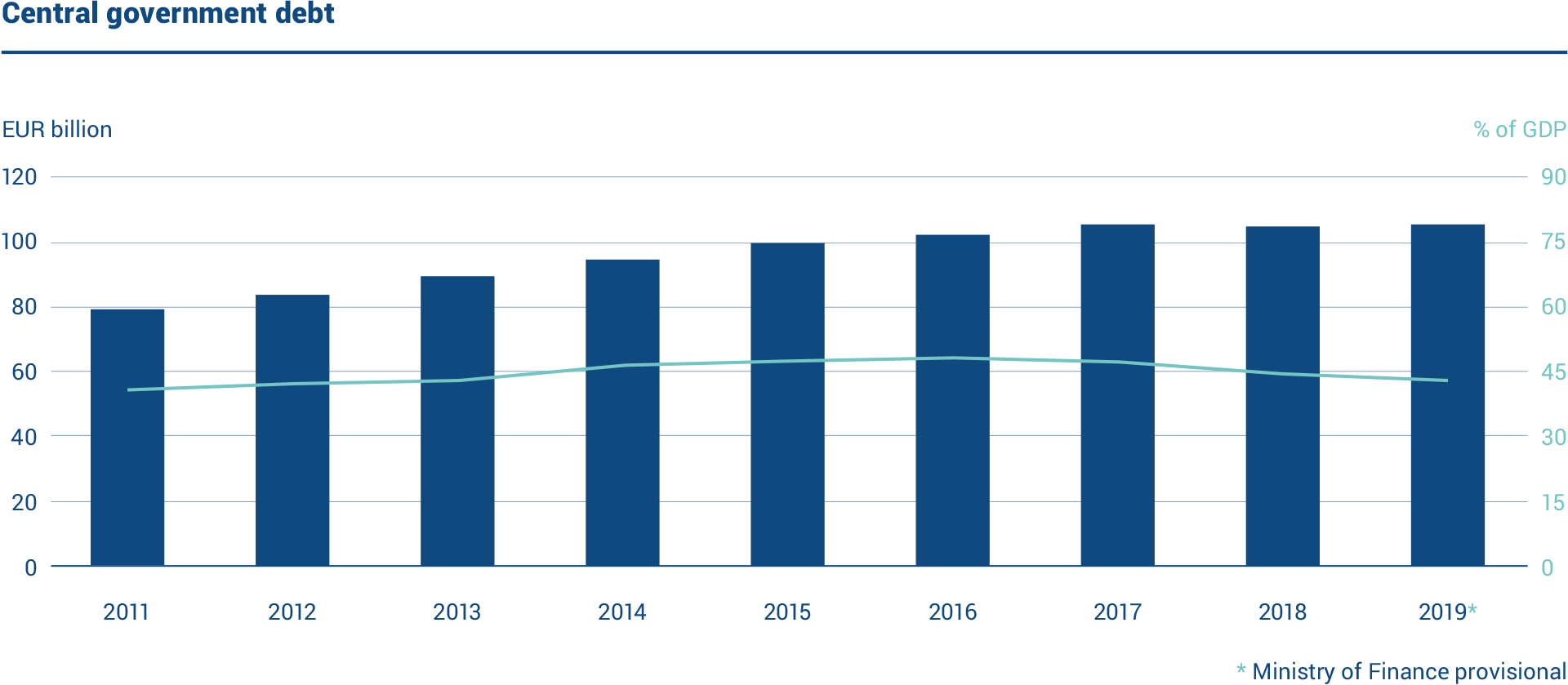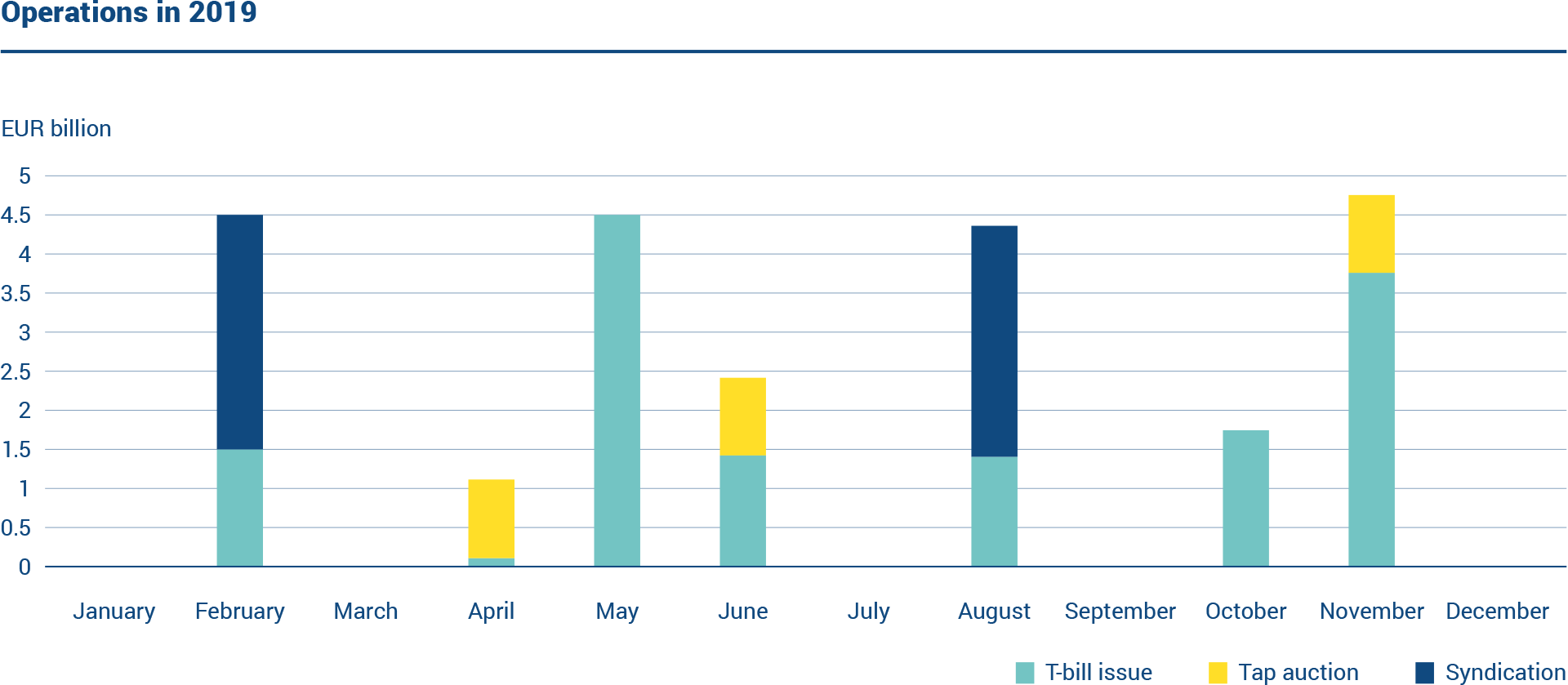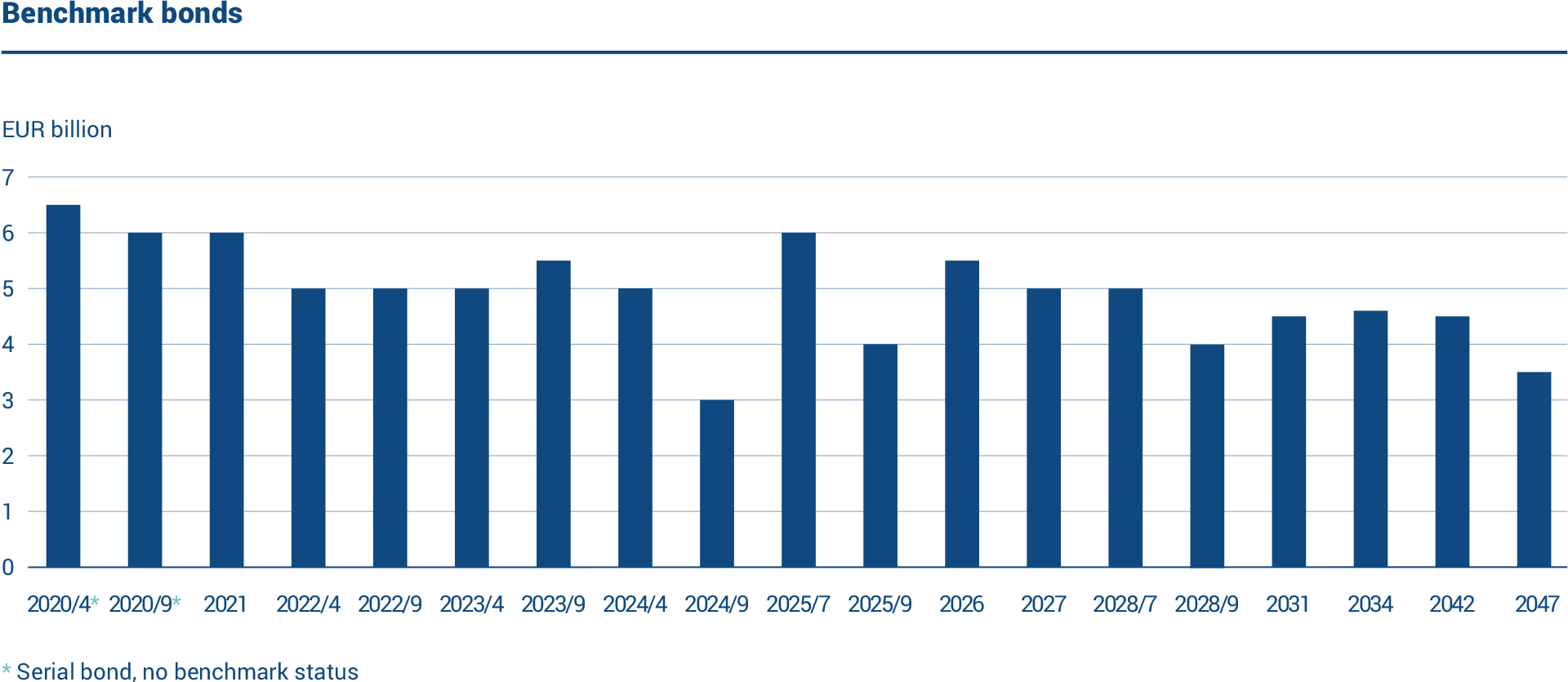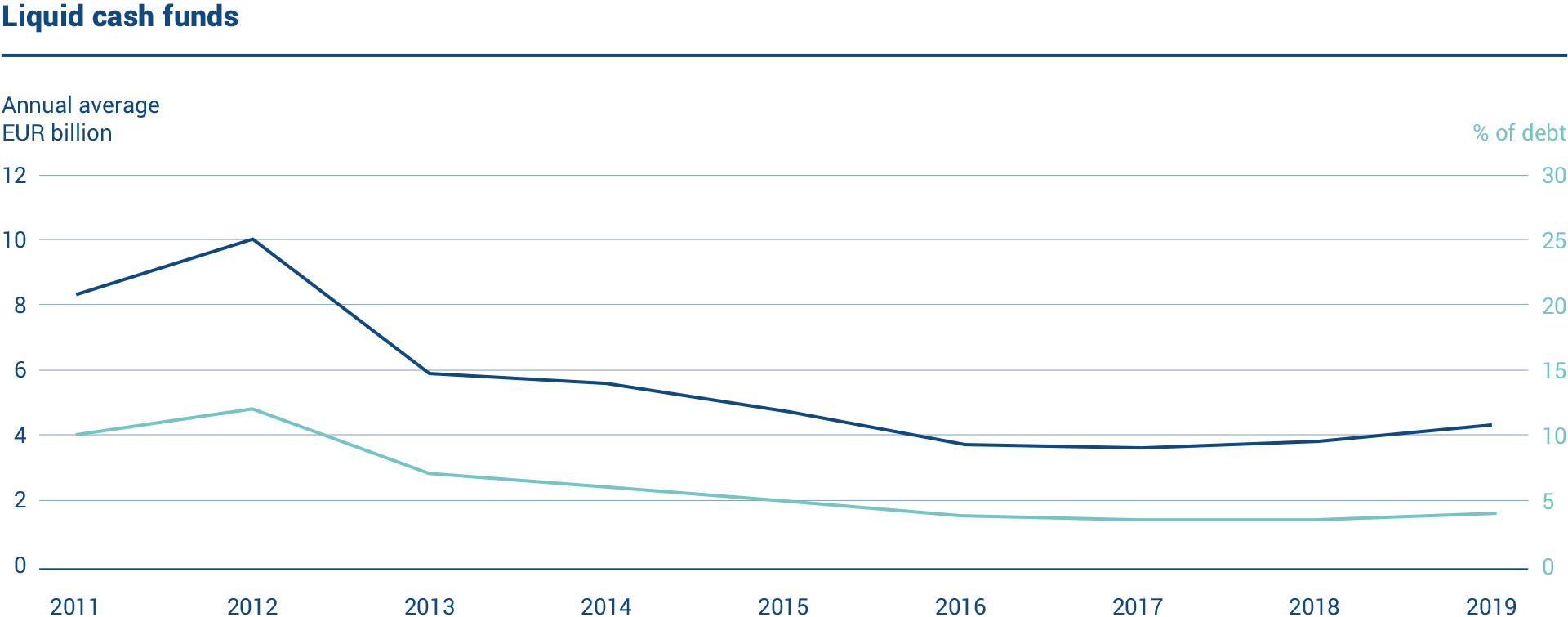The realised gross borrowing amount in 2019 was EUR 14.8 billion. Of this amount, long-term issuance accounted for EUR 8.8 billion while the rest of the total was short-term borrowing. The gross borrowing requirement for the coming years is estimated to remain around EUR 20–25 billion annually.
The budgeted gross borrowing in 2019 was EUR 15.8 billion, which included EUR 2.5 billion of net borrowing. However, due to reduced funding needs, the gross borrowing of EUR 14.8 billion was sufficient to cover expenditure on a cash-flow basis and safeguard sufficient liquidity. Since 2011, it has been possible for realized borrowing to deviate from that budgeted, thus resulting in lower borrowing. These deviations are due to e.g. adjustments in income, expenditure and cash buffers and transfers of allowances. These differences are accounted for in the government financial statements. The central government debt stock was EUR 106.4 billion at year end, i.e. EUR 1.4 billion higher than at the end of 2018.
According to the approved budget for the year 2020, the net borrowing requirement is EUR 2.3 billion. With redemptions of EUR 21.0 billion, the total borrowing requirement sums up to EUR 23.3 billion for the year. The strategy for the year 2020 is to issue a regular new benchmark bond in 10-year maturity and another new euro benchmark bond, either with a medium term (5–7 years) or a longer maturity (e.g. 15 years). Opportunities for issuance in different currencies under the Euro Medium Term Note programme will be further monitored during 2020.
Funding strategy
The funding strategy of the Republic of Finland is based on euro benchmark bond issuance. New benchmark bonds are issued in syndicated form. Syndications are complemented with bond tap auctions, which enable increases in the outstanding volumes of the existing bond lines. There is also a foreign currency bond issue programme, called the Euro Medium Term Note programme. The Republic of Finland is committed to issuing in other currencies than the euro to complement its euro-denominated borrowing and to serve a broader base of investors.
The current funding volume supports two new euro benchmark bond syndications per year, quarterly auctions, and one benchmark-sized USD bond issue. The short-term funding is carried out by issuing Treasury bills. In terms of maturities, the focus is on issuing current coupon bonds in 5- and 10-year tenors annually and 15-year bonds every three years. In addition, 30-year bond issues can be expected approximately every five years.
The State Treasury is motivated to preserve Finland’s place in the global markets as one of the reliable and acknowledged bond issuers and thus maintain attractive debt instruments and bond issuance in the future.
Funding operations
The Republic of Finland issued two new euro-denominated benchmark bonds in 2019. In addition to issuing new bonds, three tap auctions were conducted. Two of the auctions were twin-line tap auctions. The short-term funding was carried out via the Treasury bill programme.
Two new benchmark bonds were issued in syndications. The first bond issue in February was a new 10-year benchmark bond with a 2029 maturity. The issue size of the bond was EUR 3 billion. The syndication drew the strongest demand seen in Finland’s benchmark bond issues, attracting interest from more than 160 investors and an order book of EUR 14.5 billion.
The second bond issue in late August was a new 5-year benchmark bond of EUR 3 billion. The bond was met with strong demand as the order book grew to over EUR 13.6 billion, with 80 investors expressing their interest in the bond. The re-offer yield of the issue, -0.734%, was well below the ECB deposit rate and represented the lowest yield in a Republic of Finland bond syndication to date.
Tap auctions
Three tap auctions on existing euro benchmark bonds were conducted during the year. The total funded volume via bond auctions was approximately EUR 2.8 billion.
The first auction of the year was a twin-line issue conducted in mid-April for the benchmark bond maturing on 15 April 2026 and for the serial bond maturing on 15 April 2047. The auction increased the outstanding amounts by EUR 500 million each. The total outstanding amounts after the auction were EUR 5 500 million for the bond maturing in 2026 and to EUR 3 000 million for the 2047 bond. The bid-to-cover ratios of the auction were 2.0 and 1.8, respectively.
The second auction, held in early June, brought the outstanding volume of the newly issued benchmark bond maturing in 2029 from EUR 3 000 million to EUR 3 972 million. The bid-to-cover ratio was 1.5.
In November, the third and final auction of the year was also a twin line exercise, as two different maturities were auctioned. The outstanding amount of the benchmark bond maturing in 2034 was increased by EUR 567 million to EUR 4 553 million with a bid-to-cover ratio of 1.3. At the same time the outstanding amount of the bond maturing in 2047 was increased by EUR 478 million to EUR 3 478 million with a bid-to-cover of 2.1. The total size of the dual auction was EUR 1 045 million.
Short-term funding
The State Treasury issues Treasury bills in euros and US dollars through banks included in the Treasury Bill Dealer Group, according to the financing needs of the central government and in line with guidelines set by the Ministry of Finance.
In 2019, the Republic of Finland started issuing euro-denominated Treasury bills in auctions, in which the price is determined by the bids submitted by the banks. Treasury bill auctions were conducted in February, May, August and November. The total amount of funding raised in the Treasury bill auctions was EUR 5 828 million. The Treasury bill auctions will continue in 2020 with a quarterly frequency.
The State Treasury may also issue Treasury bills on other occasions, depending on the demand and financing needs, in which case the State Treasury defines the reference price for the issue. This issuance method resembles that of European Commercial Paper programmes (ECP).
The ECP-format Treasury bill issuance window was open five times in 2019: in April, May, June, October and November. Most of the issued Treasury bills were USD-denominated as the gross ECP issuance in USD was USD 7 278 million (equivalent to EUR 6 488 million) and the gross ECP issuance in euro-denominated Treasury bills was EUR 2 133 million.
The average maturity in ECP USD issuance was 4.6 months whereas similar euro-denominated trades held an average maturity of 5.1 months. The average maturity in auctioned euro-denominated Treasury bills was 3.6 months. The outstanding stock at year end was USD 4 378 million and EUR 2 028 million (USD 4 575 million and EUR 404 million in 2018).
Liquidity management
The liquidity position of the central government remained strong during the year. The amount of cash reserves is based on an assessment of sufficient liquidity and a limit on uncovered net cash flows.
The cash reserves are invested in the short-term maturities with a low credit risk exposure, e.g. triparty repo agreements are used.
Liquidity management relies strongly on the cash flow forecast system. All government accounting entities forecast their income and expenditures for the next 12-month period into the system. The State Treasury is using this data as a basis for liquidity management and funding decisions.
